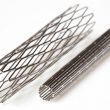Original Title: DISSECT: A New Approach to Categorization of Aortic Dissection. Reference: M.D. Dabe, et al. Eur J Vasc Endovasac Surg 2013;46:175-90 Courtesy of Dr. Carlos Fava Interventional Cardiologist Favaloro Foundation – Argentina Aortic dissection is a lethal disease, especially in its first stages. The current classification systems (DeBakey 1965 and Stanford 1970) are widely used<a href="https://solaci.org/en/2015/12/11/do-we-need-a-new-classification-system-for-aortic-dissection/" title="Read more" >...</a>
Sustained Benefit of Treatment with Drug-Coated Balloon for Femoropopliteal Lesions.IN.PACT SFA Results at 24 months
Original Title: Sustained Durability of Treatment Effect Using a Drug-Coated Balloon for Femoropopliteal Lesions. 24-Month Results of IN.PACT SFA. Reference: John R. Laird et al. J Am CollCardiol. 2015 [Epub ahead of print]. The IN.PACT SFA studies and follows up patients treated with IN.PACT Admiral DCB (Medtronic®) for superficial femoral artery (SFA) and popliteal artery disease.<a href="https://solaci.org/en/2015/11/29/sustained-benefit-of-treatment-with-drug-coated-balloon-for-femoropopliteal-lesions-in-pact-sfa-results-at-24-months/" title="Read more" >...</a>
ABSORB III: Everolimus Eluting Bioresorbable Scaffolds for Coronary Artery Disease
Original Title: Everolimus-Eluting Bioresorbable Scaffolds for Coronary Artery Disease. Reference: Stone, M.D. for the ABSORB III Investigators. N Engl J Med 2015;373:1905-1915. The ABSORB III is part of a series of randomized studies that test bioresorbable scaffolds in the clinical practice (ABSORB II, EVERBIO II, ABSORB Japan, and ABSORB IV). 2008 patients were randomized; 60% had<a href="https://solaci.org/en/2015/11/20/absorb-iii-everolimus-eluting-bioresorbable-scaffolds-for-coronary-artery-disease/" title="Read more" >...</a>
Prasugrel in the Treatment of Clopidogrel Nonresponders Undergoing PCI
Original Title: Prasugrel in Clopidogrel Nonresponders Undergoing Percutaneous Coronary Intervention (RECLOSE-3 study). Reference: Valenti R, et al. JACC Cardiovasc Interv. 2015 Oct;8(12):1563-70. Clopidogrel Nonresponders have higher risk of adverse events (cardiovascular death and stent thrombosis) compared to responders. Studies published so far have failed to demonstrate the use of platelet function tests in ACS patient<a href="https://solaci.org/en/2015/11/20/prasugrel-in-the-treatment-of-clopidogrel-nonresponders-undergoing-pci/" title="Read more" >...</a>
DAPT Substudy: Score to Personalize Optimal Dual Antiaggregation Therapy Duration
Original Title: Individualizing Treatment Duration of Dual Antiplatelet Therapy after Percutaneous Coronary Intervention: An Analysis from the DAPT Study. Presenter: Yeh RW. Optimal dual antiplatelet therapy duration for patients receiving stents has started to become clearer, but a new scoring method (DAPT Score) may help single out patients who could either benefit or suffer from extended<a href="https://solaci.org/en/2015/11/20/dapt-substudy-score-to-personalize-optimal-dual-antiaggregation-therapy-duration/" title="Read more" >...</a>
Polymer Free Drug Coated Stent in High Bleeding Risk Patients with Only One Month DAPT
Original Title: Polymer-free Drug-Coated Coronary Stents in Patients at High Bleeding Risk Reference: Philip Urban et al. N Engl J Med. 2015 Oct 14. [Epub ahead of print]. High bleeding risk patients undergoing PCI usually receive conventional bare metal stents (BMS) to allow the shortest possible DAPT (dual antiplatelet therapy), usually a month long. This<a href="https://solaci.org/en/2015/11/16/polymer-free-drug-coated-stent-in-high-bleeding-risk-patients-with-only-one-month-dapt/" title="Read more" >...</a>
OPTIDUAL: Dual Antiaggregation Not Beneficial after 12 Months.
Extending dual antiaggregation therapy (DAT) from 12 to 48 months appears not to offer extra protection after DES implantation in patients with no adverse ischemic events during the first year, neither does it increase the risk of severe bleeding. The OPTIDUAL study was carried out in 58 centers and included 1.385 patients one year after<a href="https://solaci.org/en/2015/11/16/optidual-dual-antiaggregation-not-beneficial-after-12-months/" title="Read more" >...</a>
Taxas de trombose de stent em pacientes com STEMI
Fundamentos e objetivos: Em estudos recentes sobre intervenção coronária percutânea primária (PPCI), a bivalirudina em comparação com a heparina tem sido associada ao aumento do risco de trombose de stent (ST), com taxas relatadas de ST muito variáveis. O objetivo deste estudo foi descrever a incidência de “mundo real” e os resultados de ST definitiva,<a href="https://solaci.org/en/2015/06/24/taxas-de-trombose-de-stent-em-pacientes-com-stemi-2/" title="Read more" >...</a>
ILUMIEN II: OCT guided stenting versus IVUS
The main predictor of adverse outcomes (thrombosis and restenosis) after implantation of a stent is the degree of expansion according to published studies using coronary intravascular ultrasound (IVUS). It is unknown whether optical coherence tomography (OCT), in this sense, provides similar information as the IVUS. The aim of this study was to compare the degree<a href="https://solaci.org/en/2015/06/24/ilumien-ii-oct-guided-stenting-versus-ivus/" title="Read more" >...</a>
ITALIC PLUS: 6 months of double antiaggregation for no less than 24 months
Article This multicenter study included patients receiving the second generation stent XIENCE V (Abbott Vascular) randomized to 6 and 24 months of double antiaggregation therapy after confirming non-resistance to aspirin. Primary end point was a combination of death, infarction, emergency revascularization of target vessel, stroke and major bleeding. The study saw early termination due to<a href="https://solaci.org/en/2015/06/24/italic-plus-6-months-of-double-antiaggregation-for-no-less-than-24-months/" title="Read more" >...</a>








